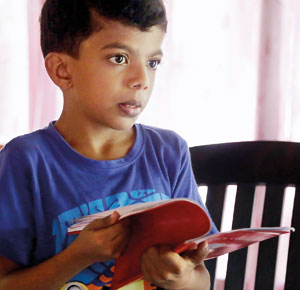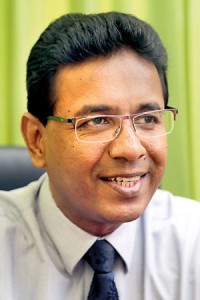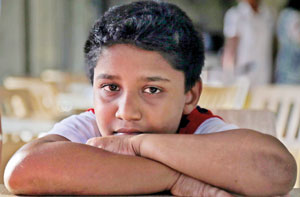Mission to keep those little hearts beating
The expertise, skills and care are available in abundance, on par or even better than centres across the world, with the dire need being a building, within the premier Lady Ridgeway Hospital (LRH) for Children in Colombo, to deal with the tiny hearts that are not beating as expected, in all corners of the country.
A dedicated 10-storey building, a centre of excellence for children’s heart health and other severe illnesses, is the vision.
As the poet said, ‘Little drops of water and little grains of sand make the mighty ocean and the beauteous land’, Consultant Paediatric Cardiologist Dr. Duminda Samarasinghe is appealing to everyone to make this vision a reality by giving anything they can spare. (See box for the achievable vision)
Vision to save 200,000 children in 20 years  Shevon loves to recite Sinhala poetry. Pix by M.A. Pushpa Kumara The plans are ready for the 10-storey state-of-the-art building costing Rs. 2 billion which will house little cardiac patients on four floors, the Medical Intensive Care Unit (ICU) on three floors, the Neonatal ICU on two floors and training facilities in critical care on the remaining floor. It may seem a huge sum of money but when looking at the bigger picture it would help save the lives of 200,000 children in 20 years. Then a child’s life would have been saved at just Rs. 10,000, reiterates Dr. Duminda Samarasinghe. The Cardiac Complex will comprise four dedicated operating theatres (OTs), a catheterization laboratory, a 36-bed ICU, a high dependency unit and wards. Not only heart patients but also newborns and children with other critical illnesses will be treated in this building. Giving the backdrop in which such a centre of excellence is needed, Dr. Samarasinghe says that Paediatric Cardiologists are stationed at the Jaffna Teaching Hospital, the Anuradhapura Teaching Hospital, the Kurunegala Hospital, the Peradeniya Teaching Hospital and the Karapitiya Teaching Hospital. Children from all over the country are referred to the LRH Paediatric Cardiac Unit for surgery and interventions as nowhere else are there Paediatric Cardiac Surgeons. Currently, heart surgery on these children is performed in two cardiac operating theatres, which had earlier been general theatres refurbished about 10 years ago. Once the surgeries are done, these children are transferred to an 18-bed ICU. A major issue is that the ICU beds are inadequate, points out Dr. Samarasinghe, explaining that only about 40% of children who need surgery can be accommodated. Meanwhile, even the OTs have not been custom-made for heart operations. Pointing out why such centres of excellence cannot be built all over the country, Dr. Samarasinghe says that the current thinking is for expertise and skill to be concentrated at one centre, according to lessons learnt from other countries. A high-volume centre with better resources results in less morbidity and mortality Citing the example of the United Kingdom, he adds that it has reduced the 11 Paediatric Cardiac Centres spread across the country to seven. |
“Sri Lankans are ‘givers’,” he says, quoting the country’s top 8th position in the ‘World Giving Index’, quite sure that the target is achievable.
Every rupee contributed to this worthy cause will help, urges Dr. Samarasinghe, requesting not only men, women and children to give of their mite but also schools, non-governmental organizations, institutions and large corporate companies to lend a hand.
The need is Rs. 2 billion for the building with four floors dedicated to more than 3,000 babies, from all strata of life, born with congenital heart disease every year.
“We at LRH need to perform 2,000 heart surgeries and 1,000 catheter interventions every year, for we service the whole nation. Unfortunately, though, we are able to perform only 1,000 heart surgeries and 700 interventions,” he says, adding that when the public makes contributions to such large-scale projects they too become the owners and guardians and not only the beneficiaries. Even in developed countries, such projects get immense public support.

Dr. Duminda Samarasinghe
The parents of three from among thousands of children who are going about their routines and leading normal lives — thanks to the gifted hands and care of the LRH heart team — are eager to tell their stories to the Sunday Times.
In Katana on Tuesday, it is seven-year-old Shevon who keeps a look out for our vehicle and points out the gate through which we should enter. As we chat to his mother, Samanthi Perera, and her tears flow at the very thought of the agony they went through with the fear of losing her younger son, he climbs onto her lap and looks lovingly at her face.
For Samanthi and her husband, it had been double agony. Their first-born, Shane, who is now 9 years old had been diagnosed with a heart issue when he was about three months. Back then in 2007, the LRH’s Paediatric Cardiac Unit had limited facilities and beds. A date would be given for the intervention but if a critically-ill baby was brought in, the staff would be compelled to use those facilities to save that baby. So in desperation, the family sold whatever they had and begged the benevolence of kith and kin to collect the large sum of money needed to get Shane’s heart repaired at a private hospital.
The second time round, as soon as baby Shevon was placed in her arms after the Caesarian birth, Samanthi realized that all was not right with his heart. The family was devastated and Samanthi was distraught, for this time it was much worse and if they had to pay private hospital bills they would have to sell the very roof above their heads and end up as paupers.
“Puduma manasika peedanayak thibbe,” murmurs Samanthi, adding that there was unimaginable mental trauma.
The hospital rounds began – this time, however, all the necessary tests such as echocardiograms for Baby Shevon were carried out at the LRH.
The LRH heart unit took the family into its fold, while both Dr. Samarasinghe and Paediatric Cardiac Surgeon Dr. Kanchana Singappuli reassured them. “We never had to run after the doctors, they would stop by us and explain everything,” says Samanthi, with tender looks at the statue of Jesus Christ which has pride of place in their home as she showers blessings on the heart team.
Implicit faith, Samanthi had in the doctors and the events are now a very stark but happy memory – Shevon undergoing the first lengthy surgery for a major heart defect plus a hole in the heart in January 2011 and another one two weeks later to close a second tiny hole in his heart.
We leave the home of Shevon after he has recited Sinhala and English poems, told us that he wishes to become an engineer and how fond he is of completing jigsaw puzzles.

Sakila in pensive mood as his parents relive the agony of his earlier illness
Next Sajeewa Priyankara and Sumithra Kumari of Dankotuwa tell us about 10-year-old Sakila and Sushen Ranatunga of Colombo about his beloved son who will turn six in September.
Soon after birth, Sakila would turn blue when he cried and was sent from Negombo Hospital where he was born to the LRH. This was in 2005 and LRH did not have the facilities to perform the necessary interventions and surgery. So the baby was taken to the Cardiology Institute of the National Hospital and then to Sri Jayewardenepura Hospital.
The waiting was unbearable and Sajeewa and Sumithra begged and pleaded for the money needed to attend to his heart at a private hospital. One intervention and two open-heart surgeries at a private hospital and nearly Rs. 1.5 million — which they could ill-afford – later, Sakila was still constantly ill. They could not collect any more money to do another open-heart surgery that was needed. It was then that Sajeewa and Sumithra heard that LRH had commenced heart operations.
“Since Sakila’s birth, we had been in hospital for 114 days,” remembers Sumithra, while Sajeewa creates the image of the family having to spread a cloth and beg by the roadside if succour had not been forthcoming from the LRH heart team.
The same sentiments about the wonder that is the heart team are expressed by Sushen, an IT expert who had lived abroad and had the means to take his little son to any centre of excellence across the world, be it Australia, Singapore, India, England or America. However, he had opted to get a device closure procedure done on his son’s tiny heart at the LRH.
“Mihipita devivaru” or ‘gods on earth’, is how these and numerous other parents who pass through the portals of the Paediatric Cardiac Unit, with heavy hearts but leave with joy as their children have got a new lease of life, describe the doctors.
While the team will remain in the very hearts of the children and families they have touched, worldwide recognition came last year when they were placed No. 1 in the ‘Cardiology Team of the Year’ category at the prestigious British Medical Journal (BMJ) South Asia Awards.
Teamwork has been the secret of success of around 200 people including Consultant Paediatric Cardiologists, Consultant Paediatric Cardiac Surgeons, Consultant Anaesthetists, doctors, nurses and minor staff. Going beyond the call of duty and certainly not watching the clock to rush off to private practice, they ‘man’ and ‘woman’ LRH’s heart unit.
(With plans underway to organize a major fund-raiser in a few weeks, please call: 0766411730 for information on how to support this project)


